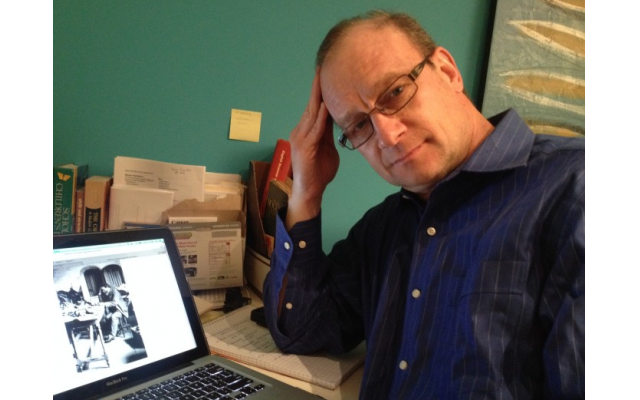Enormous Images Link Past to Present and Future
An extraordinary exhibit prompts thoughts about how to illustrate Jewish diversity in Atlanta.
Dave Schechter is a veteran journalist whose career includes writing and producing reports from Israel and elsewhere in the Middle East.
On a cold, sunlit afternoon we drove 45 minutes south to historic downtown Newnan to see a very public display of photographs illustrating the town’s diversity and change.
The day before, a story on the 17 billboard-sized images had topped the front page of Sunday’s New York Times. (Mind you, the canvases went up last spring, so this was hardly breaking news.)
The portraits are affixed to the exterior walls of buildings. Some are easily spotted, while others are tucked in alleys and around corners. After taking a break at the Leaf & Bean coffee shop, we resumed our search, locating a dozen of the portraits before driving home at nightfall.
The Rev. Jimmy Patterson, senior pastor of First Baptist Church, sat on a sofa above a grassy space between two storefronts, while Rev. Rufus Smith of New Mt. Olive Baptist Church, resplendent in a plum-colored suit, looked on from above an intersection. Patterson is white and Smith black.
Trent Citarella stood on the white-washed wall outside the Bigfoot Cycles motorcycle shop, wearing a blue, button-down shirt and a white cowboy hat, holding an American flag in his right hand.
On a wall along Perry Street, behind the Newnan Presbyterian Church, Jineet Blanco, a server at the Latino market, sat with her left hand resting on her right, wearing a colorful Mexican dress that she purchased for her 21st Birthday.
World traveler William Nathaniel Banks Jr. leaned on his cane and gazed upward from around the corner of the entrance to Full Circle Antiques. At the coffee shop, we learned that Banks had died a couple of months earlier at age 95.
Wearing a white shawl, white dress and white gloves as she attended cotillion, an African American fifth grader named Ariel graced the front of the Newman Municipal Building.
Newnan’s population has increased roughly 140 percent since 2000, to shy of 40,000 in 2019. In that time, the census classifications “white alone” (52 percent today) and African American (30 percent) have declined, while Hispanic (12 percent) and Asian (under 4 percent) representation have grown.
This is a town where monuments to “Our Confederate Dead” and to Confederate hospitals are displayed outside the Coweta County Probate Court.
This is a town where, on April 20, 2018, to mark the date Adolf Hitler was born, a few dozen white supremacists rallied at a public park, separated from hundreds of counterdemonstrators by some 700 law enforcement officers.
What began in 2016 as a two-week artist’s residency for photographer and educator Mary Beth Meehan became two years visiting Newnan, meeting townspeople and taking photographs. This is Meehan’s fourth such large-scale public installation; the first was in her hometown of Brockton, Mass.
The “Seeing Newnan” exhibit, sponsored by the University of West Georgia School of the Arts and funded by the Hollis Charitable Trust, will remain in place through the spring.
The photograph that we particularly wanted to see faces Jefferson Street, where it crosses Lee Street. To say that the portrait of Muslim sisters Zahraw and Aatika Shah generated controversy is an understatement. Examples of the vile reactions and heartening rebuttals can be found online.
Zahraw and Aatika, the Georgia-born daughters of an engineer who emigrated from Pakistan in the 1980s, sat side by side, the former’s hijab in light shades of blue and red and the latter’s a deep purple. They were honor students at Newnan High School and today attend universities in Atlanta.
Something in “Seeing Newnan” caused me to think about the diversity in Atlanta’s Jewish community. I wondered, what would a similar exhibit look like, displayed at, say, the William Breman Jewish Heritage Museum or the Marcus Jewish Community Center?
In no particular order, perhaps such an exhibit might include portraits of an Orthodox rabbi wearing a black suit, white shirt and black hat; a Reform rabbi wearing her kippah and tallit; an elderly man or woman surrounded by family photographs; a child preparing for a bar or bat mitzvah; a Holocaust survivor; an African American Jew, an LGBT Jew; Jews of Bukharian, Sephardic, Mizrachi, and Russian heritage; an interfaith family; a physically-challenged Jew and a developmentally-challenged Jew.
You get the idea. Who would you choose?
The city of Newnan bravely mounted an exhibit linking the town’s past to its present and future. The Jewish community of Atlanta might be well-served to similarly remind itself of its diversity.




comments